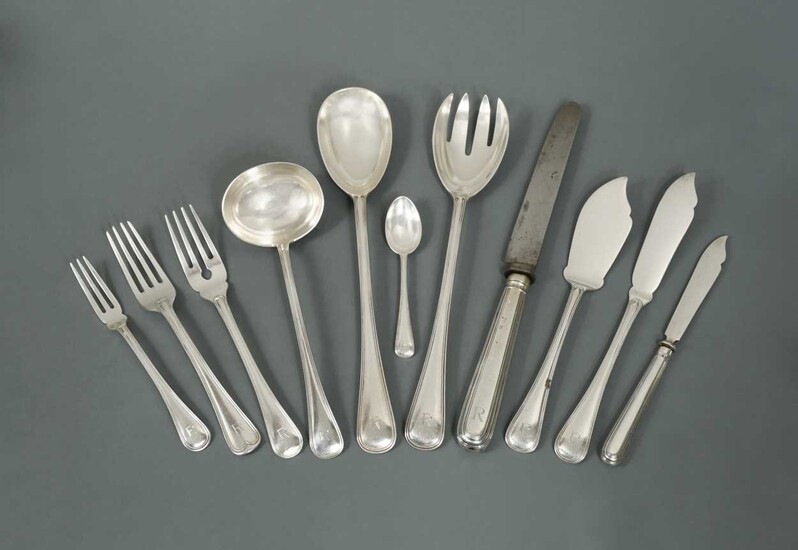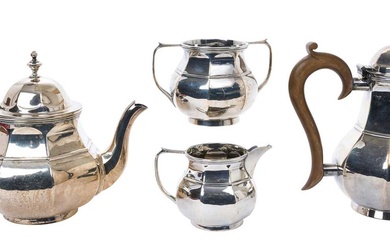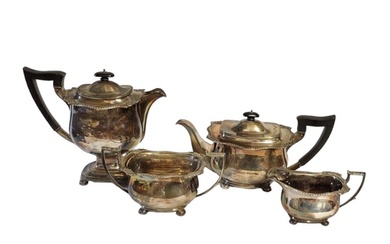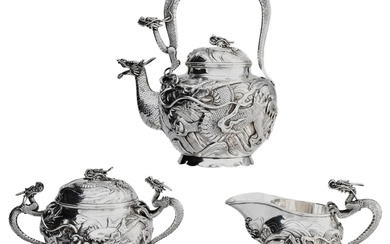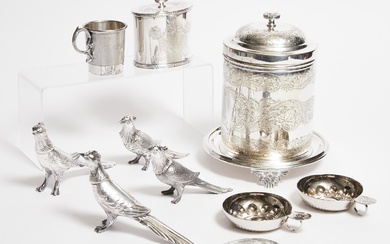An early 20th century 127-piece set of German metalwares silver cutlery and flatware
Description
mark of M.T. Wetzlar, with 'Halbmond und Reichskrone' (crescent and crown) and '800' marks indicating 800/1000 standard silver, 'Old English & Thread' pattern, monogrammed with a single letter R, comprising 8 table forks, 7 table knives with filled handles and steel blades, 9 tablespoons, 8 dessert forks, 11 dessert knives with filled handles and steel blades, 9 dessert spoons, 2 soup spoons, 7 teaspoons, 8 coffee spoons, 9 pairs of fish eaters, 12 pairs of shellfish eaters (the knives with filled handles and silver blades), a pair of basting spoons, a pair of salad servers, a soup ladle, a sauce ladle, a pair of meat carvers and a game carving knife with filled handles and steel tines and blades, a pair of fish servers, an asparagus blade, a pair of pickle forks, a butter knife and a cheese blade, 160.7ozt weighable silverProvenance:From the estate of the late Gigi Richter.Footnote: Moses Tobias Wetzlar (1847-1916), an Orthodox Jewish silversmith, opened a shop and workshops in Munich in 1875 and was soon considered to be one of the leading manufacturers and retailers of silver in the city. In 1907, Crown Prince Rupprecht of Bavaria awarded the business the title ‘Court Supplier to His Royal Highness’.When Moses died, his sons Markus, Heinrich and Alexander took over the company and in 1930, Heinrich designed the 8361-piece council cutlery for the city of Munich, which was used until 1980.When the Nazis seized power, the company suffered from reprisals. In 1938, the company was ‘Aryanized’ and the family were forced to sell the business. The Wetzlars left empty-handed due to the Reich flight tax and emigrated to England in 1939.The last of the family, Heinrich Wetzlar, returned to Munich in 1956 but found he could no longer work as a silversmith. With his suicide in 1974, the family died out.Wetzlar silverware can be seen in the Jewish Museum in Munich and in the Munich City Museum, and a special exhibition dedicated to the life and work of this important family of silversmiths was opened in 2014.
View it on
Sale price
Estimate
Time, Location
Auction House
Description
mark of M.T. Wetzlar, with 'Halbmond und Reichskrone' (crescent and crown) and '800' marks indicating 800/1000 standard silver, 'Old English & Thread' pattern, monogrammed with a single letter R, comprising 8 table forks, 7 table knives with filled handles and steel blades, 9 tablespoons, 8 dessert forks, 11 dessert knives with filled handles and steel blades, 9 dessert spoons, 2 soup spoons, 7 teaspoons, 8 coffee spoons, 9 pairs of fish eaters, 12 pairs of shellfish eaters (the knives with filled handles and silver blades), a pair of basting spoons, a pair of salad servers, a soup ladle, a sauce ladle, a pair of meat carvers and a game carving knife with filled handles and steel tines and blades, a pair of fish servers, an asparagus blade, a pair of pickle forks, a butter knife and a cheese blade, 160.7ozt weighable silverProvenance:From the estate of the late Gigi Richter.Footnote: Moses Tobias Wetzlar (1847-1916), an Orthodox Jewish silversmith, opened a shop and workshops in Munich in 1875 and was soon considered to be one of the leading manufacturers and retailers of silver in the city. In 1907, Crown Prince Rupprecht of Bavaria awarded the business the title ‘Court Supplier to His Royal Highness’.When Moses died, his sons Markus, Heinrich and Alexander took over the company and in 1930, Heinrich designed the 8361-piece council cutlery for the city of Munich, which was used until 1980.When the Nazis seized power, the company suffered from reprisals. In 1938, the company was ‘Aryanized’ and the family were forced to sell the business. The Wetzlars left empty-handed due to the Reich flight tax and emigrated to England in 1939.The last of the family, Heinrich Wetzlar, returned to Munich in 1956 but found he could no longer work as a silversmith. With his suicide in 1974, the family died out.Wetzlar silverware can be seen in the Jewish Museum in Munich and in the Munich City Museum, and a special exhibition dedicated to the life and work of this important family of silversmiths was opened in 2014.
